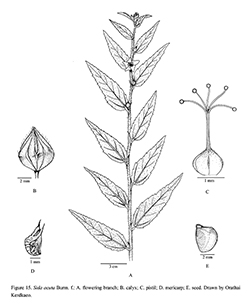e-Flora of Thailand
Volume 14 > Part 2 > Year 2019 > Page 318 > Malvaceae > Sida
1. Sida acuta Burm.f.wfo-0000496936
Fl. Ind.: 147. 1768; Roxb., Fl. Ind. Ed. 1832 3: 171. 1832; Gagnep. in Lecomte, Fl. Indo-Chine 1: 402. 1910; Craib, Fl. Siam. 1: 148. 1925; Hu, Fl. China, fam. 153: 18. 1955; Backer & Bakh.f., Fl. Java 1: 426. 1963; Borss.Waalk., Blumea 14: 186. 1966 (incl. subsp. acuta & carpinifolia); T.K.Paul & M.P.Nayar, Fasc. Fl. India 19: 202. 1988; Sivar. & Pradeep, Malvaceae S. Penins. India: 238. 1996; Y.Tang et al., in C.Y. Wu et al., Fl. China 12: 271. 2007. Fig. 15.
Accepted Name : This is currently accepted.
Synonyms & Citations :
Description : Erect Subshrub, 1–3 m tall; stems, peduncles and petioles sparsely minute–stellate hairy, glabrescent. Leaves ovate, oblong, lanceolate, or linear-lanceolate, 1.5–7 by 0.5–1.5 cm, base obtuse, apex acute or acuminate, margin dentate, sometimes entire at basal part, both surfaces glabrous or sparsely stellate hairy; 3 veins at base, secondary veins 5–6 pairs. Petiole 1–6 mm long. Stipules of each pair different, one filiform with single vein, the other linear-lanceolate, 4–6 by 1–2 mm, often longer than petiole, with 2 or more veins, usually persistent. Flower axillary, solitary, sometimes in clusters of 2–3 flowers at stem apex or on short side-shoots. Peduncle 0.3–1.2 cm long, articulated at middle. Calyx campanulate, ca 6 mm in diam.; lobes triangular, 2.5–7 by 2–3 mm, apex long acuminate, mostly glabrous, margin often ciliate. Corolla 0.8–1.5 cm in diam. Petals obliquely obovate, 6–8 mm long, apex usually emarginate, ciliate. Staminal column short, ca 4 mm long, sparsely glandular hairs. Ovary ovoid or globular, ca 1.5 mm in diam., glabrous; styles 5–8; stigma globose, yellow. Schizocarp subglobose, ca 4 mm in diam., glabrous; mericarps 5–8, trigonous, ca 3.5 by 2 mm, prominently reticulate and sulcate, apex usually with 2 awns, pubescent or glabrous. Seed trigonous, ca 2 mm long, dark brown.
Thailand : NORTHERN: Chiang Mai, Lampang, Tak; NORTH-EASTERN: Loei; EASTERN: Nakhon Ratchasima, Si Sa Ket; SOUTH-WESTERN: Uthai Thani, Kanchanaburi; CENTRAL: Saraburi, Samut Prakan, Phra Nakhon Si Ayudhaya, Krung Thep Maha Nakhon (Bangkok); SOUTH-EASTERN: Prachin Buri, Rayong; PENINSULAR: Surat Thani, Phangnga.
Distribution : India, Nepal, Bhutan, China, Taiwan, Camboia, Laos, Vietnam, Peninsular Malay, Indonesia (Java).
Ecology : In scrub land, along roadsides, wastelands, and in mixed deciduous forests.
Uses: Bark is a good fibre source, and the roots are used medicinally.

